
OVERVIEW
267 million tobacco users in India.
Among people above 15 years, 28.6% of the population currently uses tobacco products
Among youth (ages 13-15 years), 14.6% currently use some form of tobacco (boys 19.0%; girls 8.3%) and 4.4% smoke cigarettes and 12.5% use other tobacco products.
12.1% of daily users of smokeless tobacco aged 20-34 had started using smokeless tobacco when they were younger than age 15 and 36.2% of daily smokeless tobacco users aged 20-34 had started smoking or started smokeless tobacco use when they were minors i.e. younger than 18 years.
The prevalence of tobacco use varied across the states/UTs from 64.5% in Tripura to 9.7% in Goa. The mean number of cigarettes smoked per day by a daily cigarette smoker was 6.8 and the mean number of bidis smoked per day by a daily bidi smoker was 15.1.
COVID-19 Pandemic and Tobacco Use in India
Tobacco use is a major risk factor for the four main Non-communicable Diseases (NCDs) — cardiovascular disease, cancer, chronic lung disease and diabetes, which puts people with these conditions at higher risk for developing severe illness when affected by COVID-19. Smokers are likely to be more vulnerable to COVID-19 as the act of smoking means that fingers (and possibly contaminated cigarettes) are in contact with lips which increases the possibility of transmission of virus from hand to mouth. Experts have confirmed that smokers are more likely to develop severe symptoms or die from COVID-19, as it primarily attacks the lungs. Further smoking products such as water pipes or hookah often involve the sharing of mouth-pieces and hoses, which could facilitate the transmission of COVID-19 in communal and social settings. Read more
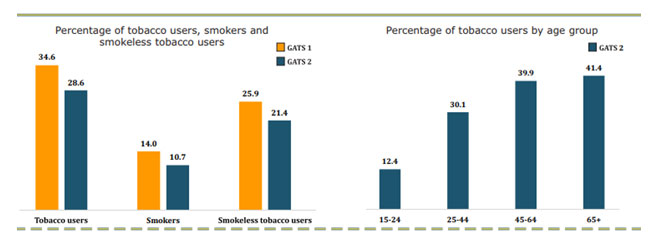
(Source : Ministry of Health and Family Welfare)
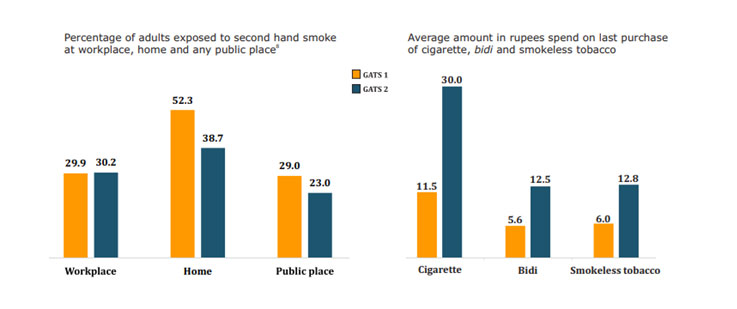
(Source : Ministry of Health and Family Welfare)
If these facts are not scary enough, there are some more.
E CIGARETTES ACT 2019 EXPLAINED
The Parliament of India passed the “ Prohibition of Electronic Cigarettes (Production, Manufacture, Import, Export, Transport, Sale, Distribution, Storage, and Advertisement) Bill, 2019” by voice vote and with long discussion in both the houses (Lok Sabha & Rajya Sabha). Read More
THE GLOBAL ADULT TOBACCO SURVEY (GATS)
The Global Adult Tobacco Survey (GATS) is a global standard for systematically monitoring adult tobacco use (smoking and smokeless) and tracking key tobacco control indicators.
GATS-1 was conducted between June 2009 and January 2010. The second survey was conducted between August 2016 to February 2017. It was conducted by Union Health & Family Welfare Ministry and Tata Institute of Social sciences. Comparing GATS-1 with GATS-2 we found an overall reduction in tobacco consumption at national level by 6% which is a very good news.
CAMPAIGN FOCUS
- To ensure that all tobacco products including bidis, cigarettes and smokeless tobacco be taxed at the highest rate of taxation
- Selling Tobacco products along with toffee /chocolate to attract children this habit needs to be curbed down with vendor licensing.
- Protecting the health of the citizens of the country by:
- Sensitizing the people on the ill effects of tobacco in any form
- Ensuring implementation of stringent laws on tobacco use especially among minors
- Generating awareness among people on second hand smoke
STRATEGY
Tobacco products are easily available at every nook and corner. Easy availability is causing an increased use of tobacco and tobacco related products among all sections of the society. The harmful effects of tobacco are not unknown and therefore there is an urgent need to decrease the use of tobacco.
So, one of the important steps taken towards this is vendor mapping in various states with support from network of state partners.
Another effort of Consumer VOICE is sensitization of stakeholders through evidence based data to have laws to facilitate selling of tobacco through licensed shops so that one can put a curb on the mushrooming of tobacco stores everywhere.
Consumer VOICE is also working towards tobacco intervention focused on youth and children.
Shops authorized for selling tobacco products cannot sell any non-tobacco products such as toffees, candies, chips, biscuits, soft drinks, etc., which are essentially meant for non-user, especially children.
It is also ensuring no tobacco shops within 100 yards of any educational institution.
Sensitization of various stakeholders such as media, consumers and people working for the social cause through educational workshops and events.
OUTCOME
A series of strong actions have been taken at both the national and state level to curb the country’s enormous tobacco epidemic, which claims one million lives each year. These actions include large, graphic warning or pictorial warning that cover 85 percent of tobacco products. India’s warnings are among the largest in the world, showing that graphic warnings depicting the deadly consequences of tobacco use work to help current users quit and prevent people from starting to use tobacco.
To prevent use of tobacco it has to be a joint effort of the government and the people. The government is doing its bit by forming several legislations like banning smoking in all public places, prohibiting advertisement and promotion of all tobacco products and sale of tobacco to minors.Quit Today,’ a toll free helpline number (1800-11-2356) to be printed on all tobacco products.
Ashim Sanyal, COO Consumer Voice welcomed the decision of the Health Ministry and said that the “Health Ministry has implemented from April 2016, large pictorial health warnings occupying 85 percent on both sides of all tobacco packages of cigarettes, bidis and all forms of chewing products. He also said said that the vendor licensing is an effective way to manage random sale of tobacco products and aims at controlled sales through registered vendors.”
Cigarettes and Other Tobacco Products (Prohibition of Advertisement and Regulation of Trade and Commerce, Production, Supply and Distribution) Act, 2003 or COTPA 2003 prohibits advertisement of and sale and supply of cigarettes and other tobacco products in India. The Ministry of Health and Family Welfare took up several initiatives to create awareness about the harmful effects of tobacco use and tobacco products out of which pictorial warning is a hugely successful one.However, the key to success is the implementation of these measures.
COTPA 2003
Cigarettes and Other Tobacco Products (Prohibition of Advertisement and Regulation of Trade and Commerce, Production, Supply and Distribution) Act, 2003
Various Sections are hereunder: –
- Prohibition of smoking in a public place (4)
- Prohibition of advertisement of cigarettes and other tobacco products (5)
- Prohibition on sale of cigarette or other tobacco products to a person below the age of 18 years and in particular areas (6)
- Restrictions on trade and commerce in, and production, supply and distribution of cigarettes and other tobacco products (7)
- Punishment for failure to give specified warning and nicotine and tar contents (20)
- Punishment for smoking in certain places (21)
- Punishment for advertisement of cigarettes and tobacco products (22)
- Punishment for sale of cigarettes or any other tobacco products in certain places or to persons below the age of 18 years (24)
WHAT IS PICTORIAL WARNING
The specified health warning shall cover at least 85% of the principal display area of the package of which 60% shall cover pictorial health warning and 25% shall cover textual health warning and shall be positioned on the top edge of the package and in the same direction as the information on the principal display area.The tenure of the existing health warning was to end on March 31, however, the Government has extended the duration of existing health warnings on tobacco packs till August 31.
New Specified Health Warning on Tobacco Products Packs
The Ministry of Health and Family Welfare, Government of India has notified new sets of specified health warnings for all tobacco product packs by making an amendment in the Cigarettes and other Tobacco Products (Packaging and Labelling) Rules, 2008 vide GSR 592 (E) dated 21st July, 2022 “The Cigarettes and other Tobacco Products (Packaging and Labelling) Third Amendment Rules, 2022”. The amended Rules will be applicable w.e.f. 1st December, 2022.
The new set of specified health warnings shall be-
- Image-1, shall be valid for a period of twelve months following its commencement from 1st December, 2022.
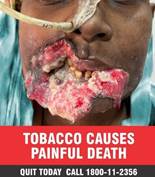

- Image-2, which shall come into effect following the end of twelve months from the date of commencement of specified health warning of Image-1.
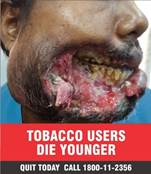
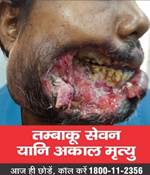
- The said notification alongwith the soft or printable version of the specified health warnings in 19 languages are available on the websites www.mohfw.gov.in and ntcp.nhp.gov.in
In view of the above, it is informed that;
- All tobacco products manufactured or imported or packaged on or after 1st December, 2022 shall display Image -1 with the textual Health Warning as ‘TOBACCO CAUSES PAINFUL DEATH’ and those manufactured or imported or packaged on or after 1st December, 2023 shall display Image-2 with the textual Health Warning ‘TOBACCO USERS DIE YOUNGER’.
- Any person engaged directly or indirectly in the manufacture, production, supply, import or distribution of cigarettes or any tobacco products shall ensure that all tobacco product packages shall have the specified health warnings exactly as prescribed.
- Violation of the above mentioned provision is a punishable offence with imprisonment or fine as prescribed in Section 20 of the Cigarettes and Other Tobacco Products (Prohibition of Advertisement and Regulation of Trade and Commerce, Production, Supply and Distribution) Act, 2003.
- The existing specified health warning (Image-2) – notified vide GSR 458(E) dated 21st July, 2020, shall continue till 30th November, 2022.
CIGARETTE PACKAGE HEALTH WARNINGS – 2018-19
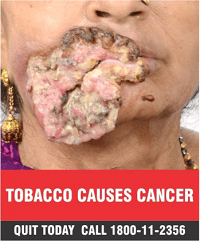
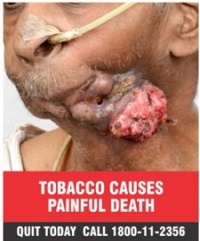
MEDIA REITERATES OUR EFFORTS
⇨ Civil society groups laud govt’s efforts on tobacco taxation
July 2, 2019 | Business Standard
Several civil society groups across India lauded the ongoing efforts of the government … Read more
⇨ 36 e-cigarette brands illegally operating in India
May 31, 2019 | ET HealthWorld.com
Even as the union health ministry continues its efforts to prevent the entry of e-cigarette …. Read more
⇨ E-cigarette industry still the centre of controversy
May 31, 2019 | Health Issue India
The controversy over the e-cigarette industry in India shows no signs of abating as …. Read more
CAMPAIGN UPDATES
International Women’s Day State events
Assam | Gujarat | Goa Assam International Women’s Day Event - Assam On International Women’s Day, Consumers’ Legal Protection Forum, Assam in collaboration with Consumer VOICE, New Delhi organized a sensitization workshop and slogan competition on 7th March 24 in...
Walkathon in Goa on World No Tobacco Day
Consumer VOICE, New Delhi in association with National Organization for Tobacco Eradication (NOTE), India and Verna Industrial Association (VIA), Goa organized an awareness rally to mark World No Tobacco Day (WNTD) on 31st May 2023 where more than 300 participants ...

















